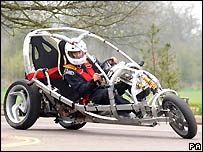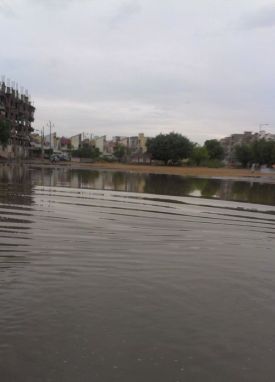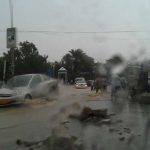Traffic situation in Karachi is getting worse with each passing day. On one hand vehicles are increasing exponentially while roads are getting blocked due to the mega-development drive of the City District Government of Karachi (CDGK). Instead of doing the development work in phases, the CDGK has opened all fronts in one go, leaving Karachi digged up from one end to the other.
Some of the recent jams were:
– June 2, 2006 – PIDC
A rally held by the Pukhtoon Action Committee (Loya Jirga) assembled hundreds of rickshaws, trucks, buses and minibuses to parade from Lasbella Chowk to the Karachi Press Club, virtually bringing life at the center of the city to a standstill from 4:00 p.m. till dusk.
The rally stretched nearly 10 kilometres long and ran opposite the flow of traffic. Traffic was blocked for hours at all the main points to Saddar – Lucky Star, Metropole hotel, Zainab market, all of I. I. Chundrigar Road.
– May 30, 2006 – Karachi Central
People blocked Nawab Siddique Ali Khan Road, running between Lasbella Bridge and Nazimabad Chowrangi, and S. M. Taufeeq Road between Teen Hatti Bridge and Liaquatabad flyover, to protest against prolonged power breakdowns in their localities. Due to the blockade, the vehicles reaching the thoroughfares from different directions got stuck at Lasbella, Nazimabad, Teen Hatti and Karimabad intersections. The power breakdown also rendered traffic signals inoperative and the traffic police personnel moved in to regulate the traffic flow failed to handle the massive clogging at so many places.
The traffic police miserably failed to regulate traffic manually and chaos like situation prevailed at Teen Hatti, Jamshed Road, Nishtar Road, Lasbella, Nazimabad, Pak Colony, Karimabad, Sir Shah Suleman Road and other link roads.
Another traffic jam occurred near Gulbai and on Mauripur Road as people took to the street and staged a sit-in. They raised slogans against the water board and the city government for reducing the supply of drinking water.
– May 19, 2006 – Jauhar More at Rashid Minhas Road:
The jam started at around 8.30 on Friday morning on the Rashid Minhas Road-Jauhar More intersection. Many of those who were caught up were students appearing in O’levels and other exams, and there was every possibility that some of them might not have made it in time.
The obvious reason was the absence of any cut between NIPA and Jauhar More to regulate traffic and enable commuters to find a convenient exit despite the fact that one of Karachi’s major amusement parks is located on this road. The result is that all vehicular traffic gets bogged down at Jauhar More. The absence of a proper service lane on either side of the Rashid Minhas Road from Jauhar More to NIPA has also made the commuters’ life miserable.
– Reasons for Traffic Jams
There are numerous reason for traffic congestion in the city, some of these are listed here:
1. Road Construction: The road construction works are in progress on M.A. Jinnah Extension Road, Rashid Minhas Road, Shahrae Jehangir, 5000 Road in North Karachi, 8000 Road in Korangi Manghopir Road etc. The flyover works are ongoing at Time Medico intersection, Hasan Square intersection and Sohrab Goth, Underpasses works are also underway at Gharibabad, Liaquatabad No. 10 and Nazimabad No. 2. Most of the projects are on going without any traffic diversion plan.
2. Encroachments: Squatters have also set up encroachments on the roads. The car showroom owners park their vehicles at footpath and on a large portion of M. A. Jinnah Extension Road, Khalid Bin Walid Road, Tariq Road, University Road etc. Inter-city buses have illegal depots and stop points along University Road (old sabzi mandi) causing hinderance in traffic flow.
3. Manual Traffic Control: According to a report in PakTribune, traffic signals are switched off in many areas by police officials who try to control the traffic manually. They get confused in the process and due to their errors, the traffic from different directions is grid locked which leads to traffic muddle on the roads. Usually, the traffic police close the traffic signals in evening when traffic volume from all directions is much higher. They open one-side of road for long period while the other traffic is closed for minutes.
Usually signals of Shaheen Complex, Civic Centre. Tibet Centre, Nishat Cinema, Numaish, Empress Market, Sharea Faisal, Shaheen Complex, Teen Hatti, Sharea Pakistan etc are switched off.
Ironically, the signals are operating under Urban Traffic Control (UTC) in which timings are fixed in according to the traffic flow of these roads. The city government has installed 130 UTC signals on major roads, which have computerized system. Timings are stored in the system in according to the traffic volume, which can also be varied.
According to city government officials, the traffic police was responsible to operate these signals but instead of it they were more intended to operate traffic manually. The city government has asked traffic police department many times to abandon traffic control manually as it causes traffic jams but the officials concerned never response positive.
4. Lack of Civic Sense: Another major reason for traffic jams and mishaps in Karachi is lack of civic sense in drivers. Most drivers are either unaware of traffic rules or they simply do not bother. Jumping lanes, overtaking, speeding, cursing and swearing, all causing frustration, depression and hyper-tension around them.
Solutions for Traffic Jams in Karachi: Solving traffic related issues is certainly no easy task and requires lot of research and planning. Considering the availability of resources and funds, it is best to utilize what is readily available rather than opting for brand-new solution which cause more strain on tax payers’ pockets. For example, the circular railway system, if properly launched, can reduce pressure from the vehicular traffic. While there was some progress on Karachi Mass Transit Program, it fall prey of various political agendas and went down the drain.
According to a BBC report, a congestion-beating project has been launched that could lead to some of the UK’s disused railway lines being paved with rubber.
 Holdfast Rubber Highway (HRH) in UK is developing rubber roads and may provide a use for some of the estimated 50m tyres disposed of in the UK each year.
Holdfast Rubber Highway (HRH) in UK is developing rubber roads and may provide a use for some of the estimated 50m tyres disposed of in the UK each year.
Parent company, Holdfast Level Crossings, already makes the rubber decking found at pedestrian and rail crossings. The company has extended this idea to create cheap interlocking panels that can be laid between the gaps on disused railway lines.
Each mile of track would use 354,000 scrap tyres. Individual panels are made “cold” so there are few emissions in the production process.
A 980ft (300m) demonstration track, funded by the not-for-profit Waste and Resources Action Programme (Wrap), has been built on a branch line leading into a car depot in Corby, Northamptonshire.
Over eight weeks, more than 8,000 cars will drive over the surface to make sure it can stand up to wear and tear.
However, Mr Coates Smith, the managing director of Holdfast, said he was more interested in seeing how quickly the road could be laid.
“It took four men five days to put down 300m of road,” he said. “The panels we’d be using [in the future] are three times as long, so you can imagine 900m in five days.”
 Also in the UK, researchers are working on a tiny, three-wheeled car that could help solve traffic congestion.
Also in the UK, researchers are working on a tiny, three-wheeled car that could help solve traffic congestion.
The prototype Clever (Compact Low Emission Vehicle for Urban Transport) car is one metre wide and less polluting than normal vehicles. It has a top speed of 100 km/h (60mph) and uses a novel tilting chassis to make it safe and manoeuvrable.
The traffic-busting two-seater is the result of a 40-month project by researchers in nine European countries.
The three-year, £1.5m EU-funded research project aimed to produce a totally different class of private motor vehicle specifically designed for the urban environment.
The idea is to try to marry the small size and efficiency of a motorcycle with the comfort and safety of a standard car.









According to my research, particularly in Karachi, Following methods could be a solution to overcome traffic congestions in Pakistan.
1. Widening of roads
2. Construction of FlyOvers and Underpasses in a scheduled and planned way (not at the same time in all locations)
3. Designated Parking
4. Intelligent traffic Controlling Systems
5. Time Staggering
6. Allocation of public school busses
7. Mobile Taxi Service
8. Three wheeled Car (or something similar)
9. Proper draining systems
Solutions:
1. Underground Subway system
2. Restoration of Circular Railways
3. Mass Transit Service
4. Ban on heavy traffic during 7 am to 12 pm
5. Construction of alternative roads
6. Lyari Expressway
7. Construction of proper parking plazas
8. Ban on animal carts
9. Shifting of intercity bus/wagon terminals outside the city
10. Shifting of major wholesale markets outside the city
11. Elimination of VIP movement blockages
The reason we have jams in the city :
1. there are no consequenses for not following the traffic rules.
2. Most people get their driving lisence without giving proper diving test: so we can well imagine what they would do when they come out on the roads!!
3. we, as a nation have become very selfish. we would rather get stuck in a jam for hours than to reverse our car!!!
4. there is absolutely no planning for any parking space , not even in commercial areas! and we pakistanis want to park our cars inside the shop – if possible, rather than parking it around the corner and walking!!!
5. traffic police are paid so less, they are more interested at making money by grabbing any oppertunity they can , catching a poor bike wala, of tankers are their favourite victims, rather than controlling the traffic.
6. as if we hadnt had enuff, the rains came!!!!!
7. now i wanna talk about the DHA authorities!!! what a mess!!!
8. Our dear friends have dug up as many roads as they could to get the water out………all the way into the sea!!!!!! God forbid if we have high tides!!!!
9. work is at a stand still and we , the residents have no idea when theses trenches will be covered!!! if ever???
10. and if you have to pick up your children from school…………..plan it 2 hours before!!! youre in for a major jam
11. there are no professional town planners in DHA at least ………….we desperately need someone to advise them!
12. the list will go on ………….but honestly , i have lost all hope from this country…………………………………… Allah help us all get through yet another day on Karachi roads!
One sentence: LAW & ORDER TO THE HIGHEST DEGREE!!
That’s the solution my dear friends. Lets take a good example:- Someone with lack of patience and discipline who breaks every traffic rule; hes also uneducated i.e by my standards just about a matriculate; hes got influential backing and has the power to intimidate traffic police when stopped – Send this same guy over to Dubai (hardly a 2 hours flight) and you will be amazed at just how much he values the fact that hes driving and needs to respect the law – or pay the consequences no matter who he is.
Thats the ONLY WAY – There is no other. Traffic mafia, Circular railways, blah blah blah sab baat ke baat ha.
@Khurram: I agree with your points 1 & 2. We need discipline and patience, lots of them. 90% of traffic jams and accidents occur due to lack of these.
About Karachi Circular Railway, well, I don’t see it happening in near future because that will seriously harm the interests of transport mafia in the city.
Government is busy in spending humongous amounts of money on building roads, flyovers and underpasses but they will all fall short of satisfying the exponentially rising demand. Only way out is reinstation of the KCR.
About alternative roads, well we have seen what sort of alternative roads and diversions are provided by the government in last 2 years of “development”. There is complete lack of any diversion and disaster management plan, whatsoever.